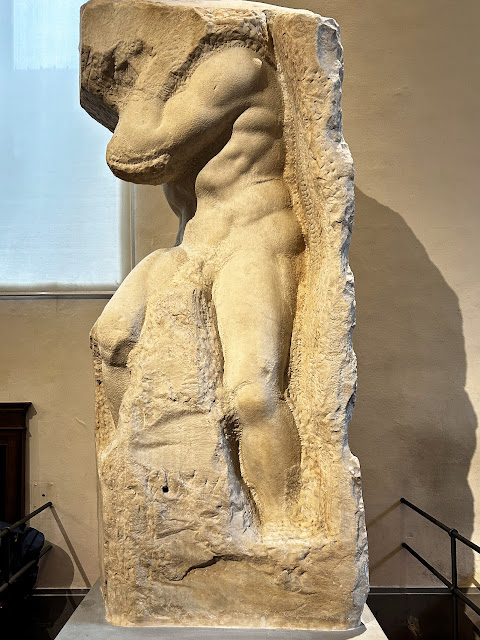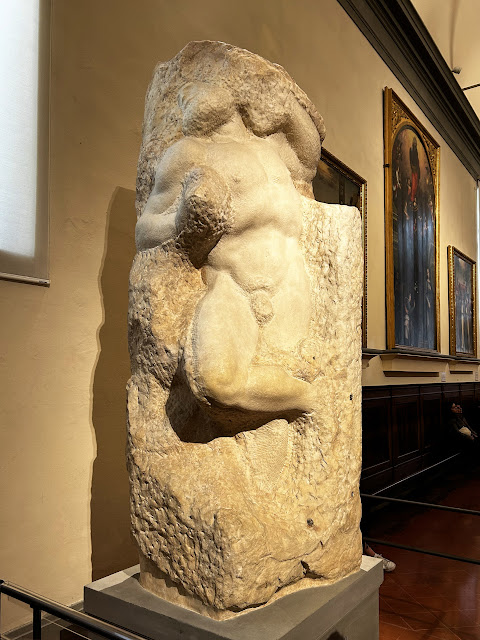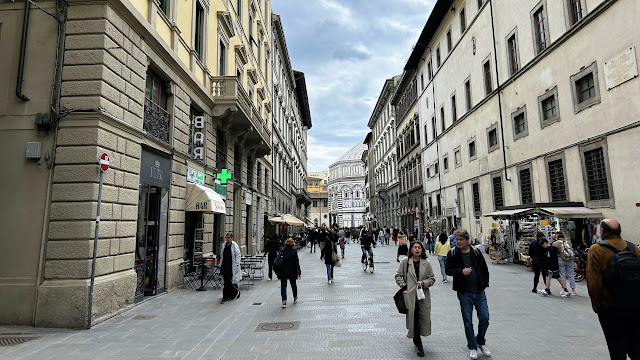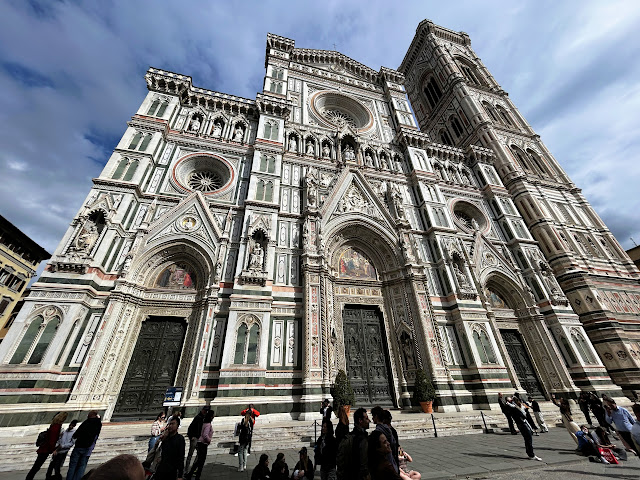Wednesday, April 3: Back on the Bus
On the morning of Wednesday, April 3, we rolled out of Rome to begin our northward trek. First stop: Florence (or Firenze in Italian), capital city of the Tuscany region, power base for the Medici family -- powerful patrons of Michelangelo and Leonardo da Vinci, birthplace of Machiavelli, and home to a surfeit of marble genitalia. (If you are a pearls-clutcher like Biagio da Cesena, consider yourself warned.)
We stopped at a service plaza along the highway for lunch where Luke and The Bear ate with me and Kristy. I sent the above "proof of life" photo back to Luke's parents. The most eye opening aspect of this stop was seeing high speed passenger trains go hurtling by at speeds that no train in North America would ever dare.
It was a brief stop and once all the musicians were well-fed, we were back on the highway bound for Firenze!
Arrival in Florence
 |
| Arrival in Florence. |
Much as I was in Germany and the Czech Republic, I was amazed by the near magical skill of our driver ("Pino") in negotiating narrow European streets in our oversized motorcoach. Our tour guide Minjon often exhorted us to show appreciation for Pino after a particularly adroit bit of maneuvering, but would quickly scold us if we were too appreciative lest we boost Pino's ego. It was clearly a fine line and Minjon obviously enjoyed keeping Pino off balance.
We were dropped off in the Piazza dell'Indipendenza (Independence Square) located in the historic center of Florence and named in honor of an 1859 uprising that ultimately led to the unification of Italy. In 1865, Florence became the capital of a unified Italy but was supplanted six years later by Rome. The statue in the distance is a memorial to 19th century Italian patriot Bettino Ricasoli. After milling about chaotically for a time, we finally set off into the city.
Street hucksters selling illegal copies of artwork were pervasive in the city, displaying their counterfeit wares on the street in hopes of enticing passersby. When the police were near, it was remarkable how quickly these prints were scooped up, seeming to vanish almost instantly.
Galleria dell'Accademia di Firenze
Outside the Galleria dell'Accademia, home to the largest number of Michelangelo sculptures in the world, we met our Odd Little Tour Guide (or OLTG). Because of its renown, entrance to the Accademia Gallery is timed for crowd control purposes. We waited patiently in line and listened to OLTG spin his tales. He explained that the city of Florence was founded on the Arno River, then proceeded to spell it for us, "A...R...N...O..."
Upon entering the Accademia, the first thing visitors see is a plaster preview study of The Abduction of a Sabine Woman (also called The Rape of the Sabines) by sculptor Giambologna. We would find the finished marble sculpture later in our exploration of the city. While Giambologna was no Michelangelo, the three figures intertwined in a striking helical arrangement that seemed to draw the eye upward and around them.
That sure is one tall piano! This vertical piano was constructed in 1739. An accompanying plaque speculates that it might represent the first time an instrument with the soundboard of a grand piano was constructed to occupy a small footprint.
On their 1997 album Reload, Metallica featured a hurdy gurdy in the song "Low Man's Lyric". Twenty seven years later, I beheld my first hurdy gurdy. So that's what one looks like! These French-made hurdy gurdies date to 1775.
This bizarre looking wind instrument is aptly called a "serpent". The instrument type is believed to be a late 16th century French invention. Obviously cumbersome, it was later supplanted by the tuba.
On learning that The Bear was an oboist, OLTG encouraged her to take a closer look at what were obviously vintage single reed instruments appearing to share more commonality with clarinets than double reed instruments like the oboe or bassoon. OLTG had already directed Izzy to a vintage cello on hearing that she was a bass player. OLTG earned many confused giggles and baffled eye rolling from our nominally polite teenagers.
Accademia's Most Famous Denizen
On encountering Michelangelo's famous David, I had two immediate, unexpected reactions. Both can be attributed to my art history ignorance.
First, I always imagined the statue to be life sized. That was clearly not the case. David is way bigger than that, a veritable Goliath. Second, along those lines, it had never occurred to me that David was the David of "David and Goliath".
Pictures utterly fail to capture the incredible attention to detail that Michelangelo put into David's musculature and, seeing it in person, it was easy to understand why the statue is so renowned. David has stood in the Galleria dell'Accademia since 1873 when it was relocated from the outdoors to protect it from weather and vandalism.
"Hall of Prisoners"
As a sculptor, it is said that Michelangelo viewed his craft as the release of pre-existing forms from the marble in which they were trapped. In viewing unfinished works partially emerging from blocks of solid stone, it is easy to imagine this to be case. The Hall of Prisoners contains multiple unfinished Michelangelo sculptures originally intended to be a part of Pope Julius II's tomb. There, they would have been depicted as nude male "prisoners" or "slaves" literally chained up and supporting portions of the structure; an interesting aesthetic for a pope to say the least. The project did not come to fruition (budget overruns) and the prisoners were left unfinished.
While the hall takes its name from these uncompleted prisoner sculptures, I found a greater poetry in the name. After all, the hall also presented these prisoners as only partially freed from their captivity within the marble.
Piazza del Duomo
After departing the Galleria dell'Accademia, OLTG led us through the streets of Florence toward the Cathedral Square.
There are so many intriguing doorways throughout Italy. This was one.
Florence's iconic duomo, completed in 1436, is a massive and intricate structure with such a presence that the camera lens is challenged to reproduce its every aspect; the photographer is torn between capturing its scale versus its detail.
Across the street from the cathedral is the octagonal Baptistry of St John. It has a design that is complementary to the cathedral, but vastly less complex.
 |
| Baptistry doors. |
 |
| Buildings surrounding the Piazza del Duomo. |
 |
| Bell tower. |
 |
| Baptistry with the duomo and bell tower behind it. |
Orsanmichele
One of the structures that caught my eye was Orsanmichele ("Kitchen Garden of St. Michael"). Constructed on the site of the kitchen garden of the San Michele monastery that no longer exists, the original structure was built as a granary in 1337 but converted to a church by the early 15th century. Used as a church by Florence's craft and trade guilds, the exterior of the structure is encircled by alcoves depicting sculpted likeness of each guild's patron saint. Pictured here is Christ with St Thomas, the patron saint of merchants.
Piazza della Signoria
When the narrow streets opened again, we had reached the Piazza della Signoria, home to the Palazzo Vecchio ("Old Palace") that was the former seat of power for the Medici family. Currently, it serves as the town hall of Florence.
In the Piazza della Signoria, we encountered our second Giambologna work of the day, a bronze likeness of Cosimo I de Medici. Cosimo was the second duke of Florence between 1537 and 1569, then reigned as the Grand Duke of Tuscany until his death in 1574. The statue was erected in 1598.
Completed in 1574, this Fountain of Neptune was commissioned by Cosimo I de Medici to celebrate the wedding of his son Francisco -- the future second Grand Duke of Tuscany -- to Joanna of Austria. By contrast, Kristy and I got some nice stoneware from my family when we were married.
Adjacent to the Palazzo Vecchio is the Loggia dei Lanzi, a covered structure with large arched openings. The Loggia dei Lanzi currently stands as an outdoor sculpture museum on the Piazzo della Signoria.
My favorite sculpture here was the Medici Lion created by Vacca in the late 16th century.
Here, we found Giambologna's completed marble sculpture for the Rape of the Sabines.
So...Perseus fought Medusa in the nude? That seems...counterproductive. The bronze likeness was created by Benvenuto Cellini in 1545.
The Rape of Polyxena was completed by Pio Fedi in 1865. Why so much raping?
The main entrance to the Palazzo Vecchio is flanked by a reproduction of Michelangelo's David on one side that replaced the original when it was moved to the Galleria dell'Accademia. On the other side is a statue depicting Hercules (standing) and Cacus, calling to mind the famous Simpsons quote, "Hi, I'm Troy McClure. You might remember me from such films as the Erotic Adventures of Hercules."
Uffizi Gallery
From the Piazzo della Signoria, OLTG indicated that we would walk through the Uffizi Gallery buildings to "...reach the River Arno, A...R...N...O..." At this point, Dena and I made eye contact and silently shared our bemusement with OLTG's need to spell Arno for us every time he uttered the name.
The Uffizi Gallery buildings were originally constructed between 1560 and 1581 as offices where Cosimo I de' Medici consolidated the bureaucracy of his regime. Today, the entire complex is an art museum including an open air courtyard that opens to the Arno (A...R...N...O...)
We did not enter the buildings, but the courtyard was decorated with statues of Florence's notable citizens. These included Leonardo da Vinci (whose name literally means, Leonardo from the town of Vinci)...
...Dante Alighieri, poet and author of the Divine Comedy...
...and even Nicolo Machiavelli, who looks almost exactly like one might expect him to look. I think he needs a goatee to stroke, but that is clearly placing a modern aesthetic on the author of The Prince.
The courtyard itself was magnificent.
Here, I am quite certain that OLTG (at left in the rust-hued coat) is spelling Arno for us again. Again, Dena caught my eye with a "come on, dude" look.
Beyond the portal from the Uffizi Gallery, we beheld the Arno (A...R...N...O...) River with the famous Ponte Vecchio (Old Bridge) in the distance. It was the only Florentine bridge spanning the Arno that was spared during World War II.
From the Arno (A...R...N...O...), we found ourselves in an alleyway on the back side of the Pallazo Vecchio.
Unsurprisingly, the rear portal to the fortified Palazzo Vecchio was impressively stout and bore the name of Cosimo de' Medici.
Here, OLTG paused and gestured toward a second story window in the Palazzo Gondi, a Florentine palace built in 1490. It is believed that Leonardo da Vinci lived in a second floor room and may have painted the Mona Lisa there.
Piazza di Santa Croce
"If I could save time in a bottle..."
Not that Croce? Oops.
The piazza is presided over by the striking Basilica of Santa Croce. While impressive in its own right, it is much smaller than the Duomo di Firenze that we visited earlier.
However, the basilica is the final resting place of many famous Florentines including single name Renaissance rockstars like Michelangelo, Machiavelli, and Galileo.
The HYSO took a group photo with the statue of Dante Alighieri next to the Basilica of Santa Croce.
A View from on High
After gathering in the Piazza di Santa Croce, we bid farewell to OLTG, secure in our knowledge of how to correctly spell "Arno". Much like our experience in Prague and other European cities, a long trek through the narrow streets of the central ancient city was necessary to rendezvous with the motor coaches. Our drivers were talented, yes, but they were not magicians.
There was something about this scene on the opposite bank of the Arno (A...R...N...O...) that struck many of us as looking particularly Italian.
Our motorcoaches conveyed us to a high overlook of Florence where the tallest structures included the tower of the Palazzo Vecchio (left) and the bell tower and dome of Florence's Duomo (center).
 |
| Photo by Dena. |
It was an enchanting view and I have absolutely no idea why I look so unhappy here. What the heck was my problem?
Oh, this picture with Mark and Dena is much better.
 |
| Photo by Dena. |
And, of course, pictured here are the reasons why we were traipsing about Europe in the first place, our wonderful children enjoying themselves on the adventure of their lifetimes. At The Bear's age, the farthest I had ever been from home was Florida. While that may sound a bit like "Florence", it is not nearly as cool.
Moral Crisis in Montecatini
 |
| View from our room's balcony. |
We overnighted at the Grand Hotel Tamerici Principe hotel in Montecatini. Though it was a bit past its prime with some decor and furnishings looking a bit tired, it was clean and comfortable. Physical, old school keys attached to heavy metal fobs that doubled as front desk hangers added to the charm. It was dinnertime where the hotel absolutely knocked it out of the park, serving a delicious buffet style meal that appealed to our allergy kids!
The hotel spanned two different, adjacent buildings whose floors did not quite line-up. Kristy and I had a room that straddled this boundary, resulting in a unique "sunken" bedroom configuration. It was all part of the charm of the place.
When booking at the hotel, the HYSO requested that the rooms be emptied of alcoholic beverages and access to adult movies be rescinded. At some point during dinner, HYSO leaders realized that these things did not actually happen, causing them to stage a commando raid of minifridges in all HYSO musician rooms while the students dined below completely unaware. An HYSO chaperone's work in Europe is rarely done!
Thus ended our third full day in Italy. In the morning, we would head to Pisa before continuing on to Cremona.































































No comments:
Post a Comment